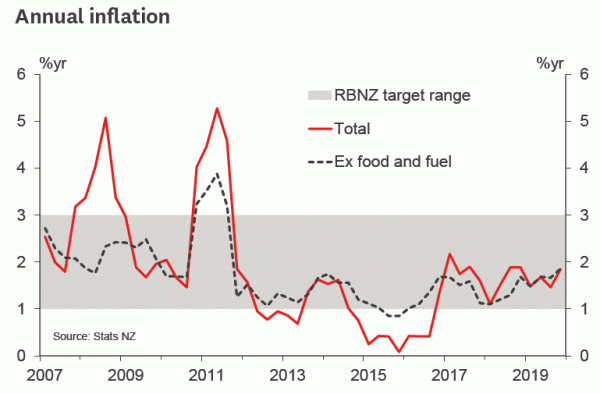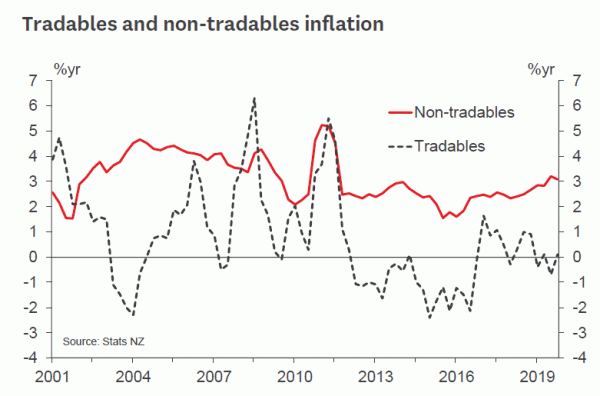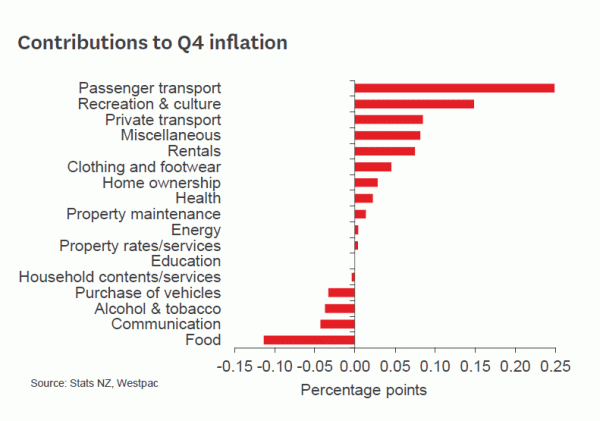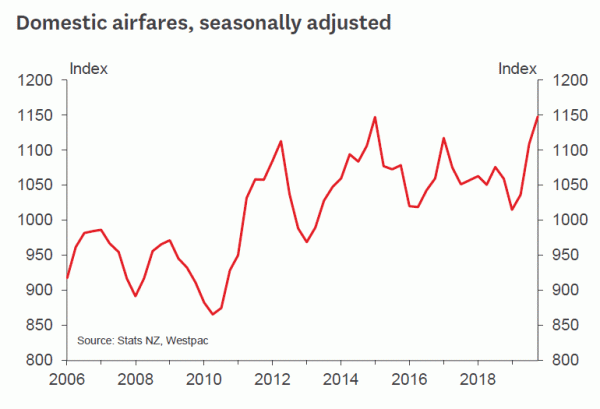- Consumer prices rose by 0.5% in the December quarter, more than we and the Reserve Bank expected.
- The surprise this time was in the more transitory ‘tradables’ categories, with some seasonal price declines being smaller than usual last year.
- The annual inflation rate rose to 1.9%, leaving it close to the middle of the Reserve Bank’s target range.
- With inflation broadly on target, we expect the RBNZ to keep the cash rate on hold over the first half of this year. However, global concerns could still prompt some further easing later in the year.
The 0.5% rise in consumer prices over the December quarter was a little stronger than both we and the market expected. This lifted annual inflation up to 1.9%, leaving it in much the same position that it’s been for the last couple of years – close to, but on the lower side of, the 2% midpoint of the Reserve Banks’ target range. The various measures of core inflation (e.g. excluding volatile items) told a similar story to the headline measure.
For the second time in a row, quarterly inflation was substantially higher than what the RBNZ expected. However, the surprise this time was on the tradables side of the index, where prices tend to be more volatile and are more affected by international conditions. In contrast, the surprise in the September quarter was on the non-tradables side, where price changes are driven more by domestic conditions and tend to be more persistent. As such, the implications for monetary policy are more modest this time around.
Nevertheless, the RBNZ’s position is looking more comfortable after today’s release. Inflation is set to remain close to target over the next year – in fact we expect it to briefly pop above the 2% mark in the March quarter. That reinforces our expectation for no OCR cuts over the first half of 2020. However, we still see the risks being balanced towards a further easing in the second half of the year, as we suspect the global economy will prove weaker than the market currently expects.
Details.
The 0.5% rise in the CPI was a relatively large increase for that time of the year, as December is typically weighed down by seasonal price declines. In seasonally adjusted terms the index rose by 0.7%, the largest quarterly increase since September 2018.
As expected, the biggest positive contributions came from the travel-related categories, including airfares, domestic accommodation and car rentals. In particular, domestic airfares surged by 11.8%, much stronger than we estimated. This will be partly due to a seasonal rise over the holiday period, but it likely also reflects reduced competition on some regional routes. Fuel prices were also slightly higher on average over the quarter.
Housing-related costs remain an ongoing contributor to overall inflation, in particular a 0.8% increase in rents (which make up almost a tenth of the CPI). We should note that Stats NZ introduced a new methodology for measuring rents last year, which tends to run a bit hotter than under the previous approach. Even taking that into account, the rise in rents was a little stronger than we expected. The recent introduction of the Healthy Homes Standards may have been a factor putting upward pressure on rents.
Food prices fell by 0.6%, a smaller than usual drop for this time of year. There were also some pockets of rising prices in import-heavy categories, such as clothing and household goods. However, these weren’t widespread enough to suggest a systemic pick-up in inflation pressures. Tradables inflation remains subdued, reflecting weak global inflation and stiff competition among New Zealand retailers. Meanwhile, a stronger local economy – supported by easy monetary policy – has helped to drive a pickup in non-tradables inflation, but the progress has been gradual.
















